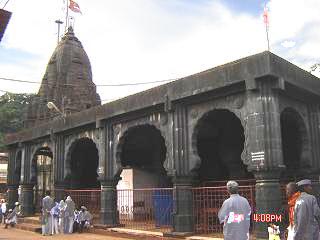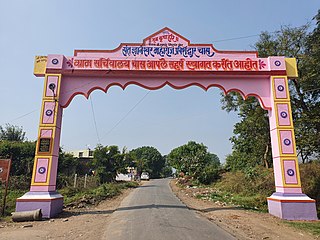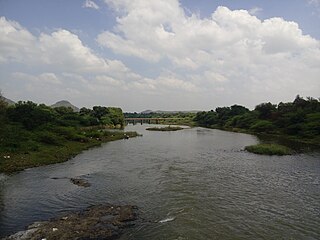
The BhimashankarMandir is a Shiva mandir situated in its eponymous village, Bhimashankar, in Pune district of Maharashtra. It is a key pilgrimage centre and one of the 12 Jyotirlinga in the world. The temple's Shiva lingam is one of the three Jyotirlinga of Maharashtra. The mandir is situated on a mountain. It is 110 kilometers away from Pune. The temple's vicinity has rare plant and animal species. The mandir is located in Khed taluka, in the Bhimashankar forest range.

The Bhima River is a major river in Western India and South India. It flows southeast for 861 kilometres (535 mi) through Maharashtra, Karnataka, and Telangana states, before joining the Krishna River. After the first sixty-five kilometers in a narrow valley through rugged terrain, the banks open up and form a fertile agricultural area which is densely populated.

Pune district is a district in Western Maharashtra with Administrative Headquarters in Pune city. Pune district is the most populous district in the Indian state of Maharashtra. It is one of the most industrialised districts in India.
Gadhinglaj ([ɡəɖᵊɦiŋɡləd͡z]) is a city in India in the Kolhapur district in the southwest corner of the state of Maharashtra, India. It is located on the banks of the river Hiranyakeshi. It is the Taluka (Tehsil) headquarters of Gadhinglaj Taluka and a subdivision headquarters of the Gadhinglaj Subdivision of the Kolhapur District. It is governed by a municipal council. The rapidly growing city is the third largest in the Kolhapur District, with population of more than 50,000. Places to visit like Samagad fort, temples and beautiful weather.
Manchar is a census town and Nagar panchayat in Ambegaon taluka of Pune district in the Indian state of Maharashtra. Nearby villages are Kalamb, Pimpalgoan, and Landewadi. It is governed by Manchar Nagar Panchayat which is second Nagar panchayat in the Pune district.
Shirur is an administrative subdivision of the Pune district in the Indian state of Maharashtra. It is located on the eastern boundary of the district, on the banks of the Ghod River. The town is also called Ghodnadi to distinguish it from other locations that have the same name. Ghodnadi in Marathi Language means Ghod River.
Bhimashankar Wildlife Sanctuary was created in the Ambegaon and Khed talukas of Pune District, in the Western Indian state of Maharashtra in order mainly to protect the habitat of the Indian Giant Squirrel.

Chas is a small town on the banks of the river Ghod River in Ambegaon taluka of Pune district in the Indian state of Maharashtra, India.

Hemadpanti Sculpture is an architectural style, named after its founder, the prime minister Hemadpant of the court of Seuna Yadavas of Devagiri.

Taluka Mulshi is a taluka in Maval subdivision of Pune district of state of Maharashtra in India. Mulshi consists of Pune Metropolitan Region & Villages.
Sherikasari is a newly separated small village from Alkuti village of Parner Taluka in Ahmednagar District of state of Maharashtra, India.
Kalwadi is a village in Junnar taluka, Pune district, of Maharashtra, India situated adjuscent to the Kukadi River and Yedgaon Dam.
Kavathe is a village located in Shirur Taluka of the Pune district of Maharashtra state. The village adds the name of local hindu goddess 'Yemai' for distinguishing from other villages in Maharashtra with similar name. Kavathe is known for it historical link with Maratha Empire and because of various folk art & artiste associated with Tamasha, drama, Jagaran-Gondhal and Bharud. Poet Bashir Momin Kavathekar and Dholak performer Shri Gangaram Bua are the two prominent folk artiste who had brought laurels with their notable contribution to the Maharashtra's performing art, culture and traditional art form Tamasha. Vithabai Bhau Mang Narayangaonkar's grandfather Shri Narayan Khude who formed his own Tamasha Troupe was also from Kavathe Yamai.

On 30 July 2014, a landslide occurred in the village of Malin in the Ambegaon taluka of the Pune district in Maharashtra, India. The landslide, which hit early in the morning while residents were asleep, was believed to have been caused by a burst of heavy rainfall, and killed at least 151 people. Rains continued after the landslide making rescue efforts difficult.

Chandoli Budruk is a village in Ambegaon Taluka of Pune district in the Indian state of Maharashtra. According to 2011 Census the population of Chandoli Budruk is 3,546 out of which 1,777 are male and 1,769 are females. There are total 692 houses in Chandoli Budruk. The GP Code of Chandoli Budruk is 185274 and PIN Code is 410 503.
Awasari Bk is a village in Ambegaon taluka of Pune District in the state of Maharashtra, India.The village is administrated by a Sarpanch who is an elected representative of village as per constitution of India and Panchayati raj (India).
Dhamani is a village in Ambegaon taluka of Pune District in the state of Maharashtra, India. The village is administrated by a Sarpanch who is an elected representative of village as per constitution of India and Panchayati raj (India).
Dimbhe Kh is a village in Ambegaon taluka of Pune District in the state of Maharashtra, India. The village is administrated by a Sarpanch who is an elected representative of village as per constitution of India and Panchayati raj (India).
Dhamani is a village in Ambegaon taluka of Pune District in the state of Maharashtra, India. The village is administrated by a Sarpanch who is an elected representative of village as per constitution of India and Panchayati raj (India).












